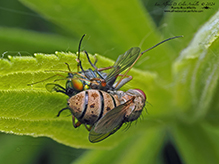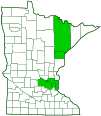common tiger fly
(Coenosia tigrina)
Conservation • Description • Habitat • Ecology • Distribution • Taxonomy
|
|
||||||||||||||
Description |
Common tiger fly is an exotic, small, predatory fly. It is native to Europe. It was introduced into North America in the early 1800s, and it has spread widely. It is most common in the northeast, the Upper Midwest, and the West Coast, though scattered populations exist throughout the rest of the United States and southern Canada, often concentrated around major metropolitan areas. Adults are active from May through September. They are found in a wide range of habitats, including at forest edges, in wet meadows, and in waste places. They are commonly found in greenhouses. They live just six to eight weeks. They are predatory on flying insects, mainly on other flies, usually smaller than themselves, but also on grasshoppers. The larvae prey on earthworms. Adults are stocky and 3⁄16″ to ¼″ (5.75 to 7.0 mm) in length. Females are yellowish gray or buff gray, and males are whitish gray. The thorax and abdomen are covered with black dots, small ones at the base of each hair, larger ones at the base of each bristle. The antennae are feather-like (plumose). The finger-like sensory mouthparts (palps) are black. The thorax is large and has three segments. The upper (dorsal) plates, from front to rear, are the prescutum, scutum and scutellum. The number and arrangement of bristles on the thorax are important identifying features. The pre-alar bristle, located in the area just in front of the alar (wing) area on the mesothorax, is missing. There is a distinct, visible line (transverse suture) running across the scutum, and there are two longitudinal rows of bristles (dorsocentral bristles). There is one dorsocentral bristle in front of the suture and three dorsocentral bristles behind the suture. Between the rows of dorsocentral bristles there is no row of bristles along the midline (acrostichal bristles). The space between the dorsocentral rows of bristles is bare. On each side of the thorax there is a plate (sternopleuron) above the middle legs. There are three bristles arranged roughly in a triangle on each sternopleuron. On the abdomen, there are large dark spots on segments 2 through 4. The wings are slightly tinted yellowish gray. The cross veins are not bordered with dark shading. On the hind legs, there is a pair of bristles very close to each other on the middle of the fourth segment (tibia). According to the literature, which is repeated literally word for word by most sources, “the mid and hind femora black with red tips.” Photos on BugGuide and iNaturalist do not bear this out. On these photos, the color is highly variable. All of the legs usually have both dark (gray, black, or both) and pale (reddish brown or brownish yellow) areas, but they may be mostly dark, mostly pale, or sometimes entirely pale. |
Size |
Total length: 3⁄16″ to ¼″ (5.75 to 7.0 mm) |
Similar Species |
Habitat |
A wide range of habitats, including forest edges, wet meadows, waste places, and greenhouses |
Ecology |
Season |
May through September |
Behavior |
|
Life Cycle |
|
Larva Food |
Earthworms |
Adult Food |
Flying insects, mainly other flies, also grasshoppers |
Distribution |
||
|
Sources |
|
| 3/30/2025 | ||
Occurrence |
||
|
||
Taxonomy |
|
Order |
|
Suborder |
Brachycera |
Infraorder |
Cyclorrhapha |
Zoosection |
Schizophora |
Zoosubsection |
|
Superfamily |
Muscoidea |
Family |
Muscidae (house flies and allies) |
Subfamily |
Coenosiinae |
Tribe |
Coenosiini |
Genus |
Coenosia (tiger flies) |
Subordinate Taxa |
|
|
|
Synonyms |
|
Caenosia sexmaculata Caricea analis Caricea communis Caricea felina Caricea fusca Caricea leonina Caricea pallipes Caricea paludosa Caricea plumosula Caricea tigrina Caricea tristis Caricea vittata Caricea vulgaris Coenosia rapax Coenosia sexmaculata Musca rapax Musca tigrina |
|
Common Names |
|
common tiger fly hunter fly killer fly tiger fly |
|
Glossary
Femur
On insects and arachnids, the third, largest, most robust segment of the leg, coming immediately before the tibia. On humans, the thigh bone.
Palp
Short for pedipalp. A segmented, finger-like process of an arthropod; one is attached to each maxilla and two are attached to the labium. They function as sense organs in spiders and insects, and as weapons in scorpions. Plural: palpi or palps.
Scutum
The forward (anterior) portion of the middle segment of the thorax (mesonotum) in insects and some arachnids.
Plumose
Feathery; having fine, pinnately arranged, lateral bristles or hairs arranged on both sides of an axis.
Tibia
The fourth segment of an insect leg, after the femur and before the tarsus (foot). The fifth segment of a spider leg or palp. Plural: tibiae.
Visitor Photos |
||
Share your photo of this insect. |
||
This button not working for you? |
||
Alfredo Colon |
||
 |
 |
|
MinnesotaSeasons.com Photos |
||
|
||
|
||

Visitor Videos |
||
Share your video of this insect. |
||
This button not working for you? |
||
|
Other Videos |
||
Fliege Coenosia tigrina |
About
Oct 31, 2013 Fliege Coenosia tigrina http://www.Insektenlexikon.ch |
Coenosia tigrina |
About
Sep 26, 2022 Coenosia tigrina is een vliegensoort van de echte vliegen (Muscidae). De volwassen vliegen jagen op insecten zoals andere vliegensoorten. Heel soms vangen zij soorten die groter zijn. De soort is vrij algemeen en wordt 6 t/m 7 mm lang. Hij is vliegt van mei tot er met september. Coenosia tigrina is 7 mm long fly of the house flies family (Muscidae). They fly from may till september and are quite common. The adults prey on smaller other insects like smaller flies but sometimes they catch insecten 3 times their normal size. |
Tiger Fly (Coenosia tigrina) |
About
Jun 8, 2021 Tiger Fly (Coenosia tigrina) with prey. |
Tiger Fly (Coenosia Tigrina) eating a Cereal Fly (Geomyza tripunctata) |
About
Sep 16, 2024 Did you know some flies are pest predators? This Tiger Fly (Coenosia tigrina) says his breakfast is GRRRREAT! It's eating Cereal for breakfast, but not cornflakes. "Tony," the Tiger fly is having another fly for breakfast, the Cereal Fly (Geomyza tripunctata). |

|
Created: 3/30/2025 Last Updated: © MinnesotaSeasons.com. All rights reserved. |





